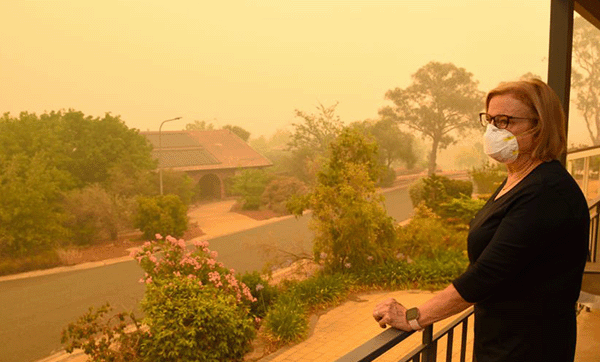Wildfires across North America have been increasing in numbers and strength in the last decade and this trend is expected to continue. This year wildfires in Canada and the United States have burned more than 49 million acres, resulting in days of hazy smoke-filled air for millions of people.
2025 is off to an active start. As of January 24, there are both wildfires and prescribed (planned) fires in the US. Some examples:
California wildfires have burned 50,683 acres
Arizona has both the Horton wildfire (8,346 acres) and a 572 acre prescribed fire.
Texas has 3 wildfires totaling 1126 acres and an 185 acre prescribed fire.
Florida has a large 8810 acre (Bicy Boot Hill Rx) prescribed fire.
Colorado has 7 prescribed fires totaling 1855 acres.
Alabama has one 1056 acre prescribed fire (Hubbard Barbaree Rx)
Breathing in wildfire smoke has all sorts of health effects, especially to the respiratory system and the sinuses. The smoke is especially irritating for persons already dealing with sinus problems. Health effects can be short-term or long-term depending on how long you are exposed to the smoke.
Smoke from wildfires is air pollution
When there is discussion of how wildfire smoke affects air quality, it is usually referring to the levels of particulate air pollution (PM2.5) in the air. These are the very small particles or particulate matter 2.5 microns or smaller - so small that they can travel deep into the lungs and nasal passages and cause inflammation and irritation.

But the term PM2.5 only tells you about the particle size. Smoke also has different chemicals in it depending on what is on fire. Burning vegetation and trees release different pollutants into the air than burning cars and buildings, which release more hazardous air pollutants.
Health effects from wildfire smoke
Wildfire smoke causes inflammation throughout the body within minutes. It is highly irritating to the respiratory system and worsens lung functioning, even in healthy individuals. The smoke also worsens existing respiratory problems such as asthma and COPD (chronic obstructive pulmonary disease).
Common symptoms from breathing in wildfire smoke, even in healthy people, are: coughing, trouble breathing normally, stinging eyes, a scratchy throat, runny nose, irritated sinuses, wheezing and shortness of breath, chest pain, headaches, an asthma attack, tiredness, and fast heartbeat.
While breathing in smoke results in inflammation of the nasal passages in everyone, persons with sinusitis are especially bothered by the smoke. This is because they already have nasal and sinus inflammation, that is, inflammation of the mucous membranes lining the sinuses. Studies find a worsening of sinusitis, and an increase of symptoms such as runny nose, congestion, mucus, and post-nasal drip.
Children, those with preexisting respiratory illnesses (e.g., asthma, COPD) and heart disease, older adults, pregnant women (including the developing fetus), and those with occupational exposure are the most vulnerable to wildfire smoke. For example, studies of children found an increase in emergency department visits for respiratory problems and asthma hospitalizations within the first 3 days of exposure to wildfire smoke, especially in children under 5 years of age.
Development of chronic sinusitis
There is a link between smoke exposure and the development of chronic sinusitis – the more smoke exposure a person has, the greater the risk of developing chronic sinusitis. This is why firefighters are the occupation at greatest risk for developing chronic sinusitis.

Some research has looked at chronic sinusitis and air pollution, including particulate air pollution PM2.5 (the same particles found in wildfire smoke). The studies find that the higher the levels of air pollution that a person is exposed to – the greater the risk of developing sinusitis and the greater the inflammation of the sinus tissues. Even the hair-like cilia in the sinuses (which move mucus into the nasal passages) can be damaged by the small PM2.5 particles.
Health effects can be short-term or long-term
If you’re a healthy individual, chances are very good that your body will recover from short term smoke exposure. This is very reassuring!
Unfortunately, the respiratory health effects can be long-lasting after exposure for many days or weeks. Much is still unknown, but studies are showing such effects as higher rates of influenza (flu) two months later, and decreased lung function even two years later. Firefighters have not only an increased risk of developing chronic sinusitis, but also an increased risk of new onset asthma.
Protecting yourself from wildfire smoke
- Stay indoors as much as possible with the windows and doors shut.
- Use an air purifier in your home like the Austin Air Healthmate.
- Avoid air cleaners that produce ozone (ozone is a lung irritant). If needed, can make your own air cleaner as a short term solution (videos).
- Use high quality air filters in your A/C system. Filters labeled “MERV13” or higher are most effective for removing smoke particles.
- Try not to do outside work or strenuous outdoor exercise.
- Monitor the outdoor air quality by going to a site such as airnow.gov. The site also has fire and smoke maps.
- Can wear a N95 mask when outdoors on days the air quality is very poor.
- Do not do anything in your home that will add to indoor air pollution. This means don’t light candles, use the fireplace, or smoke.
- Can use a saline nasal rinse or spray to help with nasal symptoms (e.g., congestion).
- If you develop sinusitis, you can use L. sakei (Lanto Sinus) to help with sinus symptoms.
- Stay hydrated by drinking plenty of fluids.
- Keep pets indoors as much as possible. Birds are especially vulnerable to wildfire smoke.
Children need extra protection
A fact sheet “Protecting Children From Wildfire Smoke and Ash” has been prepared by the American Academy of Pediatrics and EPA with good tips.
Be prepared and take precautions! (Updated post 2025)


Leave a comment: